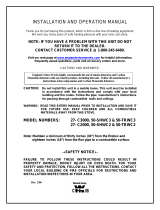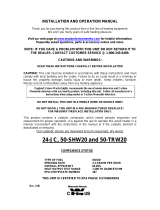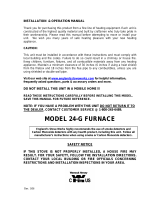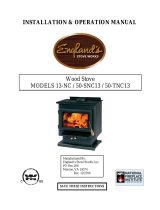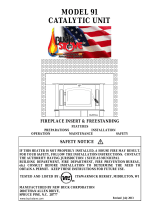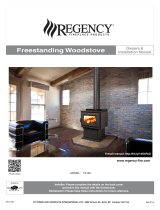
C. Installation of a New Flue System
1. Masonry Flue: In the event that you plan to install a flue system or have a flue
system installed, there are several avenues you can take. In the middle and late
Seventies masonry flue systems became very popular, and are satisfactory
systems to have today. If you are considering a masonry system, you should
consult your local building officials for the proper procedures in construction of this
type flue system. We recommend you consult with and have your flue built by a
licensed, bonded contractor.
Most masonry flues are placed against the outside wall and extend upward
above the roof. The flue thimble is then inserted through the wall, making the
connection with the vertical flue and the stovepipe. Exercise extreme caution when
drilling through the wall; you must maintain the proper clearance between the
connecting liner and any combustibles in the wall.
We also recommend that you have a flue door located at least two feet (2’)
below your flue thimble connection for easy access and clean-out. You should
make this door as airtight as possible. It is the responsibility of the consumer to
ensure the chimney or flue system is in good operating condition. The
manufacturer will not be responsible for an accident attributed to a unit
connected to a faulty chimney or flue system.
2. Pre- Manufactured Flue System: In the past few years pre-manufactured flue
systems have become very popular because this type system is fairly easy to install
and, when installed correctly, is very safe. There are many pre-manufactured flue
systems on the market from which to choose. In making your choice be sure the
system you choose has a recognized label such as U.L., B.O.C.A. or I.C.B.O. Any
of these labels will ensure the flue system is constructed of the proper materials
and meets the required safety standards. Your Englander dealer will usually handle
a top grade and approved flue system.
There are
two very popular methods for installation of a pre-manufactured flue
system. The
most popular and least expensive is through the ceiling and out the
roof. This is the least expensive and creates a tremendous draw because less pipe
is required. It is less expensive because insulated pipe is only needed from the
ceiling up; single wall 24 gauge pipe is used from the unit to the ceiling. The
second method of installation is to go through the wall and up on the outside of the
house or structure. This method is more expensive because more insulated pipe is
required; you must use insulated pipe through the wall and up the outside of your
house. If you choose to go through the ceiling or through the wall, you must
exercise extreme caution in your installation. The proper clearances must be
maintained with either installation. Your flue pipe manufacturer furnishes a wall
thimble or ceiling box, and when these are installed properly the correct safety
clearances will be met. If you choose this type system and are not qualified to
install it, you can contact your local dealer for a qualified contractor. It is the
responsibility of the consumer to ensure the chimney or flue system is in good
operating condition. The manufacturer will not be responsible for an accident
attributed to a unit connected to a faulty chimney or flue system.
*IMPROPER INSTALLATION: The manufacturer will not be held responsible for damage
caused by the malfunction of a stove due to improper venting or installation.
Call
800-245-6489
and/or consult a
rofessional installer if
ou have an
uestions.





















